Family name: Araceae A.L. Jussieu
Synonym(s): Arisaraceae Raf.; Caladiaceae Salisb.; Callaceae Rchb. ex Bartl.; Cryptocorynaceae J. Agardh; Dracontiaceae Salisb.; Lemnaceae Martinov, nom. cons.; Orontiaceae Bartl.; Pistiaceae Rich. ex C. Agardh; Wolffiaceae Bubani
Common name(s): arum family
*Number of genera/species: 114/3,750
fruit or seed
Fruit a simple berryberry:
an indehiscent, fleshy fruit with one or a few to many seeds. The flesh may be homogenous throughout. Or, if the outer part is hard, firm, or leathery, referred to as an hesperidium. Septa are present in some, and the seeds may be arillate or with a fleshy testa.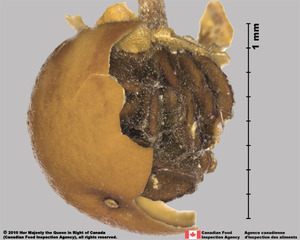 , rarely a multiplemultiple:
, rarely a multiplemultiple:
fruit formed from several flowers clustered in one mass
berryberry:
an indehiscent, fleshy fruit with one or a few to many seeds. The flesh may be homogenous throughout. Or, if the outer part is hard, firm, or leathery, referred to as an hesperidium. Septa are present in some, and the seeds may be arillate or with a fleshy testa. , utricleutricle:
, utricleutricle:
a small, indehiscent, dry fruit with a thin wall (bladderlike) that is loose and free from the seed, derived from a single, superior, simple ovary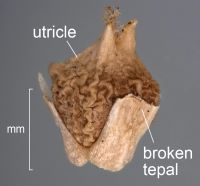 , rarely an irregularly dehiscentdehiscent:
, rarely an irregularly dehiscentdehiscent:
(v. dehisce) splitting open at maturity to release contents (of a fruit)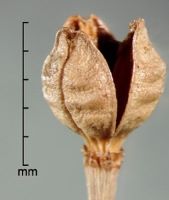 capsulecapsule:
capsulecapsule:
a dry, dehiscent fruit derived from a compound ovary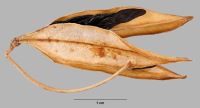 , 0.5–30 mm long, globoseglobose:
, 0.5–30 mm long, globoseglobose:
3D shape—more or less spherical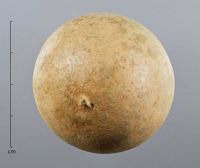 to polygonalpolygonal:
to polygonalpolygonal:
angular
, tereteterete:
approximately circular in cross section; width and thickness approximately equal
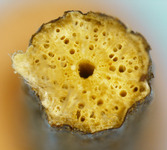 in transection, sometimes stylesstyle:
in transection, sometimes stylesstyle:
in a flower, the narrow and elongated part of the pistil between the stigma and the ovary; sometimes persisting in fruit persistent, with one to many seeds. Pedicelpedicel:
persistent, with one to many seeds. Pedicelpedicel:
the stalk of a flower
, perianthperianth:
collective term for calyx and corolla of a flower
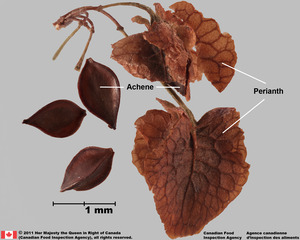 , or bracts often persistent. Pericarp red, orange, purple, green, yellow, or white, rarely blue or brown, shinyshiny:
, or bracts often persistent. Pericarp red, orange, purple, green, yellow, or white, rarely blue or brown, shinyshiny:
uniformly reflecting a high proportion of incident light at all angles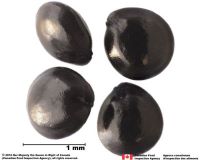 , membranousmembranous:
, membranousmembranous:
texture—extremely thin, pliable, and fairly tough
to fleshy, ribbedribbed:
surface relief—wide, prominent, linear ridges that are generally rounded and longitudinally situated on the surface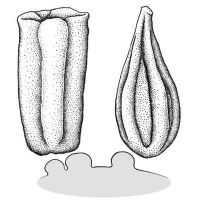 , wrinkledwrinkled:
, wrinkledwrinkled:
surface relief—shallow, irregular folds and furrows covering the surface; appearing overall though crumpled and then spread out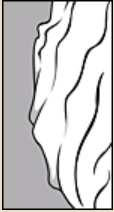 or papillatepapillate:
or papillatepapillate:
surface relief—bearing minute, distinct, broad-based projections, tapering to a rounded apex .
.
In Syngonium and Cryptocoryne, fruits united into a syncarpsyncarp:
fruit derived from fusion of numerous ovaries in a many-flowered inflorescence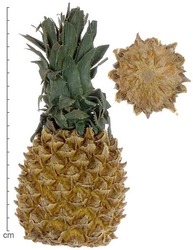 , which is indehiscentindehiscent:
, which is indehiscentindehiscent:
not opening on its own, as in a fruit
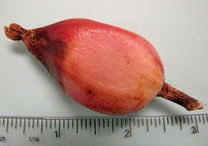 in Syngonium and dehiscentdehiscent:
in Syngonium and dehiscentdehiscent:
(v. dehisce) splitting open at maturity to release contents (of a fruit) apically in Cryptocoryne appearing star shaped. BerriesBerry:
apically in Cryptocoryne appearing star shaped. BerriesBerry:
an indehiscent, fleshy fruit with one or a few to many seeds. The flesh may be homogenous throughout. Or, if the outer part is hard, firm, or leathery, referred to as an hesperidium. Septa are present in some, and the seeds may be arillate or with a fleshy testa. basally dehiscentdehiscent:
basally dehiscentdehiscent:
(v. dehisce) splitting open at maturity to release contents (of a fruit) in Lagenandra.
in Lagenandra.
In genera formally placed in Lemnaceae (Lemna, Spirodela, Wolffia, and Wolffiella), fruits are usually a one-seeded utricleutricle:
a small, indehiscent, dry fruit with a thin wall (bladderlike) that is loose and free from the seed, derived from a single, superior, simple ovary , often laterally winged near the apexapex:
, often laterally winged near the apexapex:
the point farthest from the point of attachment, or the "tip" of an organ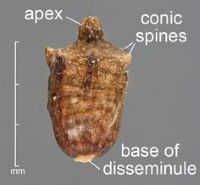 .
.
Seeds variable in shape, sometimes strongly curvedcurved:
(of embryo) linear embryo is curved into an arch or horseshoe with the ends far apart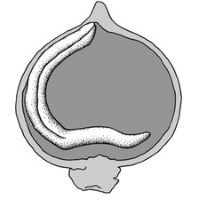 , flattened or tereteterete:
, flattened or tereteterete:
approximately circular in cross section; width and thickness approximately equal
 in transection, sometimes triangulartriangular:
in transection, sometimes triangulartriangular:
2D shape—three relatively straight sides with distinct corners; more angular than teardrop-shaped , 7–30 mm long, often surrounded by mucilaginousmucilaginous:
, 7–30 mm long, often surrounded by mucilaginousmucilaginous:
resembling mucilage; moist and sticky
pulp, sometimes sticky. Seed coat white, yellow, brown, or black, shinyshiny:
uniformly reflecting a high proportion of incident light at all angles , variable texture, thickness, and relief, but never pubescentpubescent:
, variable texture, thickness, and relief, but never pubescentpubescent:
surface relief—bearing hairs
.
OperculateOperculum:
a dehiscent cap (or lid) of a seed or fruit that opens during germination or dehiscence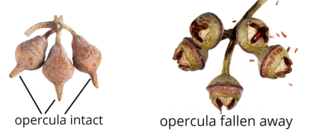 in Pistia. Arillate in Areae, Arisarum, and Ambrosina. Seeds with long (straight or curvedcurved:
in Pistia. Arillate in Areae, Arisarum, and Ambrosina. Seeds with long (straight or curvedcurved:
(of embryo) linear embryo is curved into an arch or horseshoe with the ends far apart ) micropylarmicropyle:
) micropylarmicropyle:
an opening in the integuments of an ovule usually acting as a passage for the pollen tube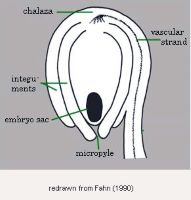 appendages in Bucephalandra, Hottarum, Piptospatha, and Phymatarum. Rapheraphe:
appendages in Bucephalandra, Hottarum, Piptospatha, and Phymatarum. Rapheraphe:
a ridge or seam on the seed coat, formed by the portion of the funiculus united to the ovule wall in longitudinally curved ovules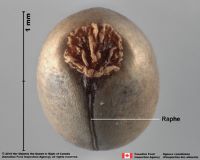 S-shaped in Monstera.
S-shaped in Monstera.
In Lemna, Spirodela, Wolffia, and Wolffiella, seeds are more or less minute, longitudinally ribbedribbed:
surface relief—wide, prominent, linear ridges that are generally rounded and longitudinally situated on the surface or smooth, and with pointed opercula and dark-pointed chalazas.
or smooth, and with pointed opercula and dark-pointed chalazas.
Embryo straight if endosperm present or curvedcurved:
(of embryo) linear embryo is curved into an arch or horseshoe with the ends far apart if endosperm lacking. Embryo minute and apicalapical:
if endosperm lacking. Embryo minute and apicalapical:
at or pertaining to the end of the seed or fruit distal from its point of attachment (i.e., base)
in Pistia. Embryo and endosperm, if present, usually green.
Endosperm copious to absent.
Aquatic, terrestrial, and epiphytic plants. Aquarium & Pond Plants of the World tool includes descriptions and images of genera in this family.
| Fruit | |
| Type | capsulecapsule: a dry, dehiscent fruit derived from a compound ovary  , berryberry: , berryberry:an indehiscent, fleshy fruit with one or a few to many seeds. The flesh may be homogenous throughout. Or, if the outer part is hard, firm, or leathery, referred to as an hesperidium. Septa are present in some, and the seeds may be arillate or with a fleshy testa.  , utricleutricle: , utricleutricle:a small, indehiscent, dry fruit with a thin wall (bladderlike) that is loose and free from the seed, derived from a single, superior, simple ovary  |
| Size range | 0.5–30 mm long |
| Shape(s) | ovoidovoid: 3D shape—ovate 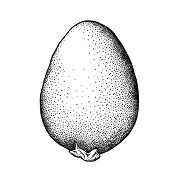 , ellipsoidellipsoid: , ellipsoidellipsoid:3D shape—elliptic , oblongoblong: 2D shape—much longer than broad with nearly parallel sides, corners are rounded 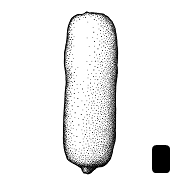 , teardrop-shapedteardrop-shaped: , teardrop-shapedteardrop-shaped:2D shape—widest point is toward one end of the fruit, the other end tapers sharply to a pointed end 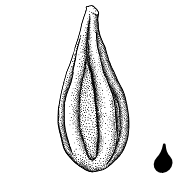 , cylindricalcylindrical: , cylindricalcylindrical:3D shape—a cylinder, with parallel sides and a circular cross-section; tubular or rod-shaped , globoseglobose: 3D shape—more or less spherical  , cuneiformcuneiform: , cuneiformcuneiform:wedge-shaped , polygonalpolygonal: angular , trigonoustrigonous: 3D shape—having three faces that meet at distinct angles; triangular in outline |
| Texture | chartaceouschartaceous: papery, papyraceous , membranousmembranous: texture—extremely thin, pliable, and fairly tough , fleshy, leatheryleathery: texture—moderately thick, tough, and very pliable |
| Surface relief | wrinkledwrinkled: surface relief—shallow, irregular folds and furrows covering the surface; appearing overall though crumpled and then spread out  , papillatepapillate: , papillatepapillate:surface relief—bearing minute, distinct, broad-based projections, tapering to a rounded apex  , ribbedribbed: , ribbedribbed:surface relief—wide, prominent, linear ridges that are generally rounded and longitudinally situated on the surface  |
| Color(s) | blue, brown, green, orange, purple, red, white, yellow |
| Seed | |
| Size range | 0.7–30 mm long |
| Shape(s) | ellipsoidellipsoid: 3D shape—elliptic , reniformreniform: 2D or 3D shape—kidney-shaped 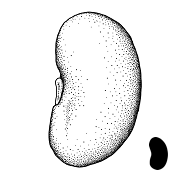 , globoseglobose: , globoseglobose:3D shape—more or less spherical  , cylindricalcylindrical: , cylindricalcylindrical:3D shape—a cylinder, with parallel sides and a circular cross-section; tubular or rod-shaped , oblongoblong: 2D shape—much longer than broad with nearly parallel sides, corners are rounded  , ovoidovoid: , ovoidovoid:3D shape—ovate  , fusiformfusiform: , fusiformfusiform:spindle-shaped; broadest at the middle and tapering at both ends 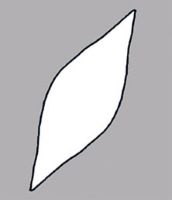 , cordiformcordiform: , cordiformcordiform:3D shape—heart-shaped |
| Surface relief | wrinkledwrinkled: surface relief—shallow, irregular folds and furrows covering the surface; appearing overall though crumpled and then spread out  , ribbedribbed: , ribbedribbed:surface relief—wide, prominent, linear ridges that are generally rounded and longitudinally situated on the surface  , ridgedridged: , ridgedridged:surface relief—raised, thick ridges, sharp edged or rounded, usually in a series that may cover the entire surface 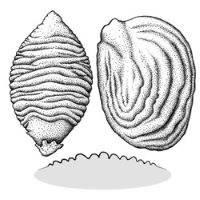 , roughenedroughened: , roughenedroughened:texture—having a small, stout, stiff, more or less acute protrusions , wrinkledwrinkled: surface relief—shallow, irregular folds and furrows covering the surface; appearing overall though crumpled and then spread out  , striatestriate: , striatestriate:surface relief—having fine, parallel lines, grooves or ridges 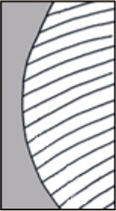 , reticulatereticulate: , reticulatereticulate:surface relief—netted, raised walls or concave grooves forming a net-like surface pattern with flat, concave, or convex interspaces  , ruminateruminate: , ruminateruminate:testa or seed coat folded into the endosperm 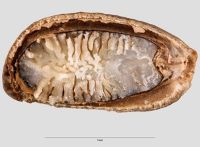 , pittedpitted: , pittedpitted:surface relief—surface with small depressions in which the areas between the hollows do not take on the appearance of a true reticular net  , wartywarty: , wartywarty:surface relief—distinct, rounded projections that are large relative to the fruit size; tuberculate, verrucose  |
| Color(s) | white, brown, yellow, black |
| Other | |
| Embryo | straight or curvedcurved: (of embryo) linear embryo is curved into an arch or horseshoe with the ends far apart  , usually chlorophyllous , usually chlorophyllous |
| Nutritive tissue | endosperm copious to absent, sometimes chlorophyllous |
World-wide distribution.
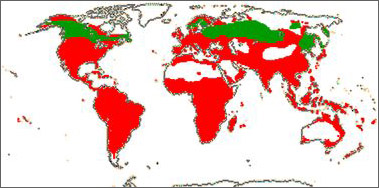
Distribution map courtesy of Angiosperm Phylogeny Website.
Baskin and Baskin 2021Baskin and Baskin 2021:
Baskin C and Baskin J. 2021. Relationship of the lateral embryo (in grasses) to other monocot embryos: A status up-grade. Seed Science Research 31 (3): 199-210. doi:10.1017/S0960258521000209; Cronquist 1981Cronquist 1981:
Cronquist A. 1981. An integrated system of classification of flowering plants. Columbia University Press, New York. 1261 pp.; Dahlgren et al. 1985Dahlgren et al. 1985:
Dahlgren RMT, Clifford HT, and Yeo PF. 1985. The families of the monocotyledons: structure, evolution, and taxonomy. Springer-Verlag, Berlin. 520 pp.; Flora of Australia 2021+Flora of Australia 2021+:
Flora of Australia. Australian Biological Resources Study, Canberra. Accessed January 2021–March 2024. URL: http://www.ausflora.org.au; Flora of North America Editorial Committee 1993+Flora of North America Editorial Committee 1993+:
Flora of North America Editorial Committee, eds. 1993+. Flora of North America North of Mexico [Online]. 22+ vols. Flora of North America Association, New York and Oxford. Accessed January-March 2024. URL: http://beta.floranorthamerica.org.; Hepper 1973Hepper 1973:
Hepper FN. 1973. Lemnaceae. In: Polhill RM, ed. Flora of Tropical East Africa Vol 96. Crown Agents for Oversea Governments and Administrations, London UK. 9 pp.; Kirkbride et al. 2006Kirkbride et al. 2006:
Kirkbride JH, Jr, Gunn CR, and Dallwitz MJ. 2006. Family guide for fruits and seeds, vers. 1.0. Accessed September 2020-January 2022. URL: https://nt.ars-grin.gov/seedsfruits/keys/frsdfam/index.cfm .; Kubitzki et al. 1990+Kubitzki et al. 1990+:
Kubitzki K et al., eds. 1990+. The families and genera of vascular plants. 7+ vols. Berlin etc.; Mayo 1985Mayo 1985:
Mayo SJ. 1985. Araceae. In: Polhill RM, ed. Flora of Tropical East Africa. AA Balkema, Rotterdam, Netherlands. 71 pp.; Thiselton-Dyer 1897Thiselton-Dyer 1897:
Thiselton-Dyer WT. 1897. Flora capensis: being a systematic description of the plants of the Cape colony, Caffraria, amp; Port Natal (and neighbouring territories). Vol. 7. L. Reeve, Kent UK. 791 pp. https://doi.org/10.5962/bhl.title.821; Tropicos.org 2021+Tropicos.org 2021+:
Tropicos.org. 2021+. Pakistan Plant Database. Missouri Botanical Garden. Accessed January 2021–April 2024. http://legacy.tropicos.org/Project/Pakistan; Tutin et al. 1964–1980Tutin et al. 1964–1980:
Tutin TG, Burges NA, Chater AO, Edmondson JR, Heywood VH, Moore DM, Valentine DH, Walters SM, and Webb DA (eds.) 1964–1980. Flora Europaea. 5 vols. Cambridge University Press, Cambridge UK. 2,524 pp.; Zhengyi et al. 2004+Zhengyi et al. 2004+:
Zhengyi W, Raven PH, and Deyuan H. 2004+. Flora of China [online]. 25 vols. Science Press, Beijing China & Missouri Botanical Garden, St. Louis USA. Accessed January–March 2024. http://flora.huh.harvard.edu/china/
*The number of genera and species is based on Christenhusz and Byng 2016Christenhusz and Byng 2016:
Christenhusz MJM and Byng JW. 2016. The number of known plant species in the world and its annual increase. Phytotaxa 261 (3): 201-217. https://doi.org/10.11646/phytotaxa.261.3.1, which may differ from the number of genera in GRIN-Global.